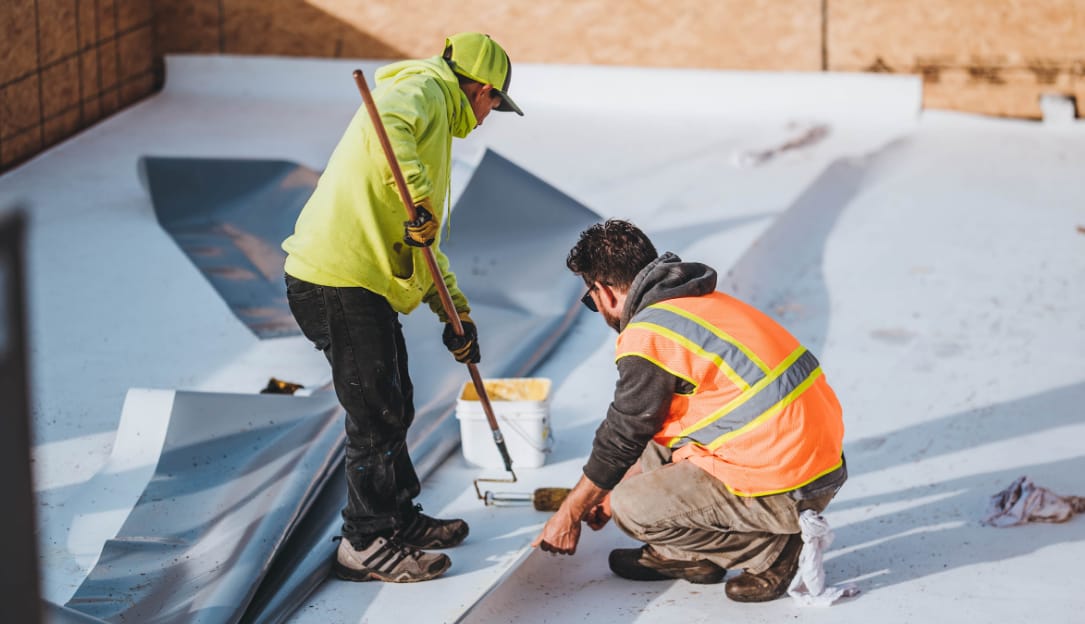When choosing a roofing material for your building, considerations about durability, cost, and energy efficiency often come to the forefront. Thermoplastic Polyolefin (TPO) roofing is one of the hottest topics in today’s roofing world, as its affordability, ease of installation, and energy efficiency make it a popular choice for commercial buildings.
Thank you for reading this post, don't forget to subscribe!Wondering whether TPO roofing meets the specifications of your project? This ultimate guide will break down everything you need to know—from its makeup to its advantages, cost and maintenance.
What Is TPO Roofing?
Thermoplastic Polyolefin (TPO) is a single-ply roofing membrane mostly used in commercial roofing applications for flat or low-slopes. Though it sounds like it, TPO is not entirely plastic, and is a blend of polypropylene and ethylene-propylene rubber.
The material comes in large rolls and is made to create a watertight seal with minimal seams on flat surfaces. TPO membranes are very versatile and are available in a variety of widths and thicknesses, which enables contractors to accommodate different specifications required for the building.
Benefits of TPO Roofing
Thermoplastic Olefin roofing has been gaining traction in recent years and for a lot of good reasons. And that’s why so many building owners and contractors have embraced this versatile material:
Energy Efficiency
TPO roofing is a good option for those interested in minimizing energy use. Its white or light-toned surfaces reflect sunlight and can keep a building’s interior cooler, reducing the need for air-conditioning in hot months. This quality makes TPO especially well-suited for sun-drenched areas.
Affordability
Other roofing materials such as Ethylene Propylene Diene Monomer (EPDM) or Polyvinyl Chloride (PVC) are relatively more expensive compared to TPO. It provides much of the benefit you would get from higher-end materials, without the exorbitant price point, making it an affordable investment for many companies.
Durability
Having one of the best tear and puncture resistance out of any roofing system, along with the ability to resist water pooling, TPO roofs are ideal for your next commercial project. TPO also resists UV radiation, ozone exposure, and chemical pollutants, which contributes to the longevity of the roofing system.
Eco-Friendly
TPO roofing is more environmentally friendly option. TPO membranes not only save energy; they are also 100% recyclable and are made from non-toxic and non-halogenated materials by many manufacturers.
Seam Strength
TPO roofing seams are heat-welded for strength, and when installed correctly, best practices will ensure they hold up. Which makes these seams stronger, and them less likely to leak than adhesive based seams found in many EPDM and other alternatives.
Cost Considerations
There are additional factors such as the size and complexity of the roofing system, the thickness of the membrane, and labor cost in your area that goes into determining the cost of TPO Roofing installation.
Typical Pricing
The average price for TPO roofing is $5 to $10 per square foot, including installation. This cost is typically less than PVC roofing, and a bit more than EPDM roofing.
Factors Influencing Cost
The thicker, the more durable membranes are, but also, the more expensive.
Initial Installation vs Replacement: When you are initially installing a TPO roof, the costs will be lower than when you are replacing an old one, since the latter will involve extra demolition and repairs before installation.
Increased Insulation: The cost would go up if you add extra insulation with TPO.
In summary, TPO is not overly expensive, but working with experienced roofing contractors means that you will be getting the best value for your investment.

Installation Process
To get the durability and performance of TPO roofing over time, it is very important to install it properly. Here’s a quick overview of the how-to:
Preparing the Roof Surface
Before installation can begin, the surface must be clear of dirt and debris. A full tear-off may be required if you’re replacing the old roofing material.
Installing Insulation Layers
Install Insulation Boards to Create a Smooth Base These layers help thermal benefits and also give a good base to the membrane for applying on.
Laying the TPO Membrane
TPO membranes are laid out in sheets on the roof. The material can be secured using one of three main methods:
- Using screws and washers as a mechanical means of attachment that allows for expansion and contraction.
- Fully Adhered-preferably the membrane directly glued to an insulation layer.
- Ballasted with gravel to hold the membrane (less common, because of the weight).
Heat-Welding Seams
Finally, the seams between membrane rolls are fused together, hermetically and waterproof by means of a heat welder, to avoid leaking.
Quality Assurance
Lastly, contractors examine the installation from top to bottom to identify if there are any openings or vulnerabilities that could jeopardize the roof’s structure.
Maintenance Tips
The lifespan of your TPO roof can generally be around 15 to 25 years and proper maintenance is the key to prolong it. Here are some best practices:
Conduct Regular Inspections
Perform an inspection at least semiannually, and post-severe weather, such as heavy rain, hail or high winds. Check for signs of punctures, tears or puddles.
Clear Debris
To avoid drainage problems, regularly brush off leaves, dirt and other debris. Make sure the roof’s drainage systems are not blocked.
Fix Leaks or Holes Esta Pronto
Take care of small tears or seam damage before they grow into bigger issues, such as leaks or compromised structural performance. This will allow the roof to function much longer if repaired in a timely manner.
Expert Cleaning Services
Think about booking yearly check ups with a roofing expert for more extensive examinations and fixings.
Is TPO Roofing Right for You?
Choosing the right roofing material will largely depend on your specific needs, budget, and building type. TPO is a really great option for:
Low-Slope – or Flat – Rooftops typical of Commercial and Industrial buildings
Climate Adaptation, particularly in warmer climates where UV Resistance and Energy efficiency are invaluable.
What about Green Initiatives for companies focused on sustainability and environmentally-friendly construction materials.
When you carefully review your building’s needs, you can determine if TPO roofing is the best fit for your performance, aesthetics, and budget requirements.
If you’re ready to learn more about the advantages of TPO or need professional guidance, contact a local roofing contractor for a thorough consultation.



